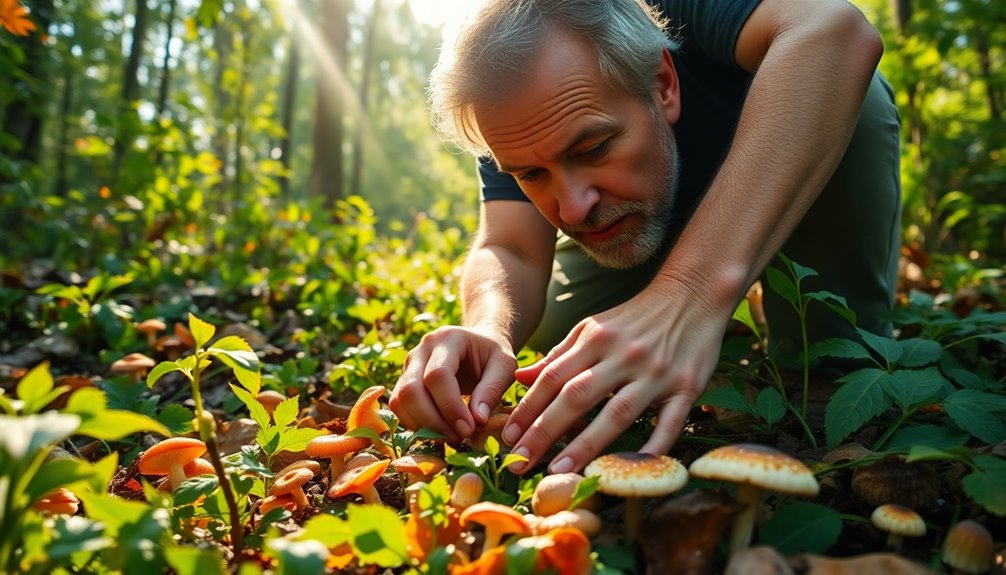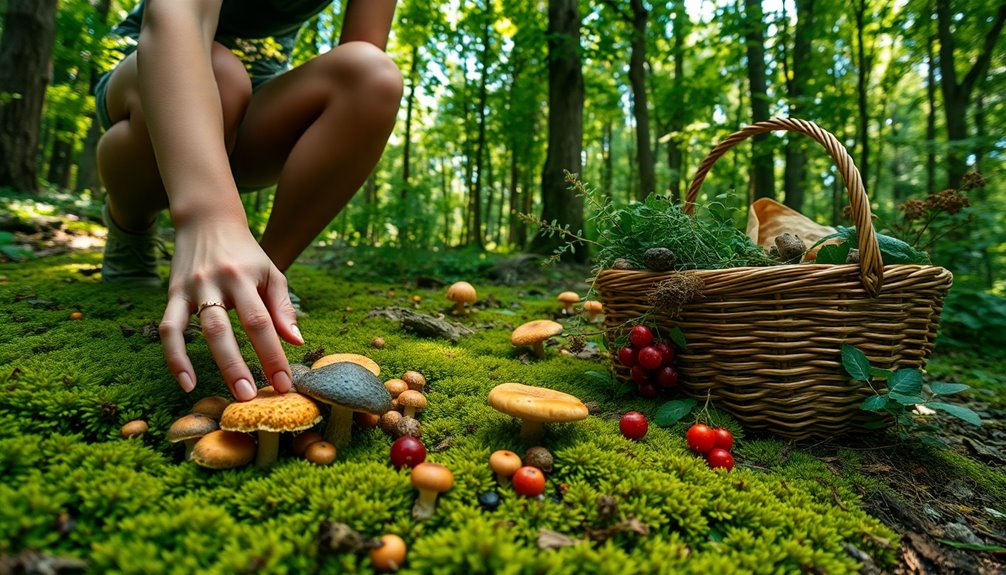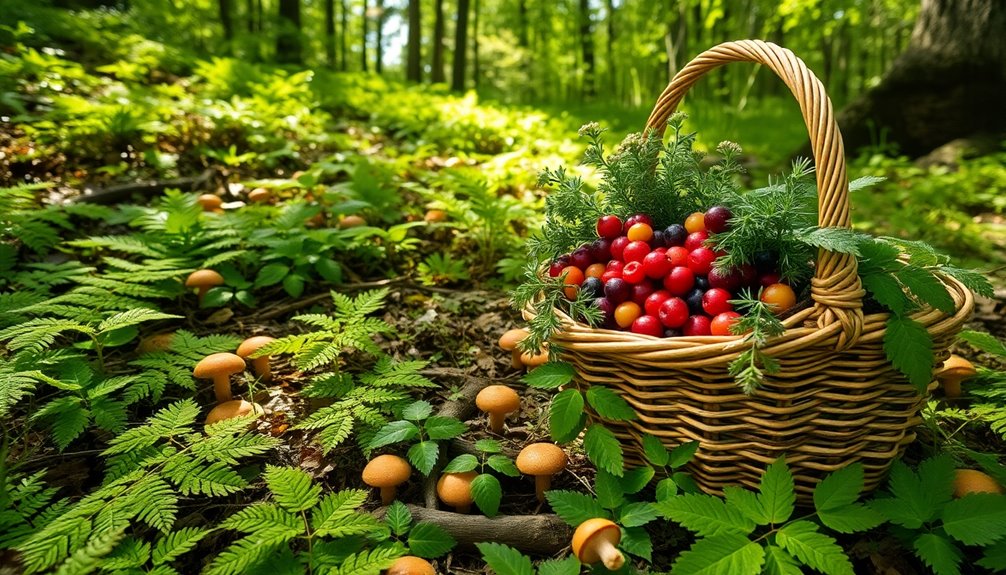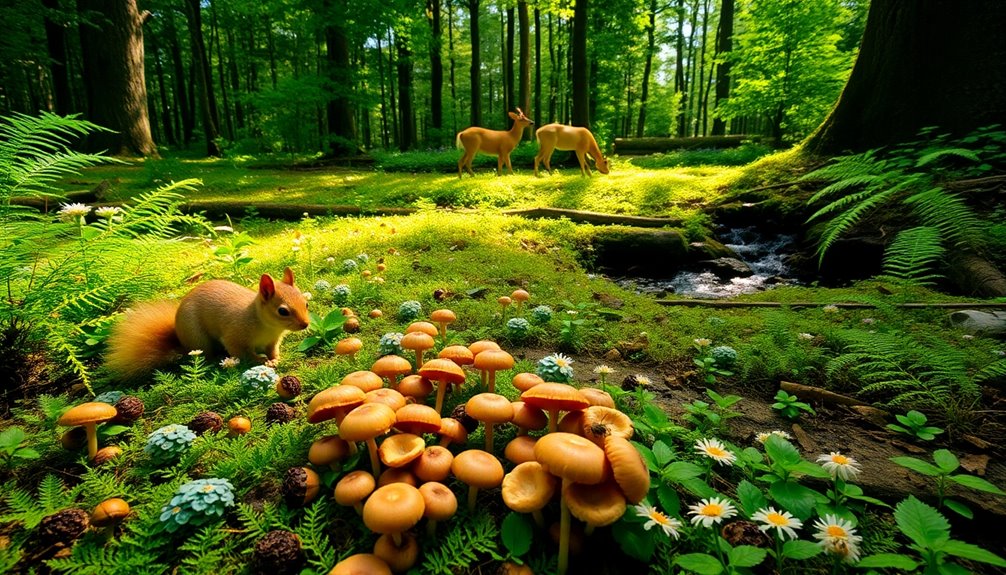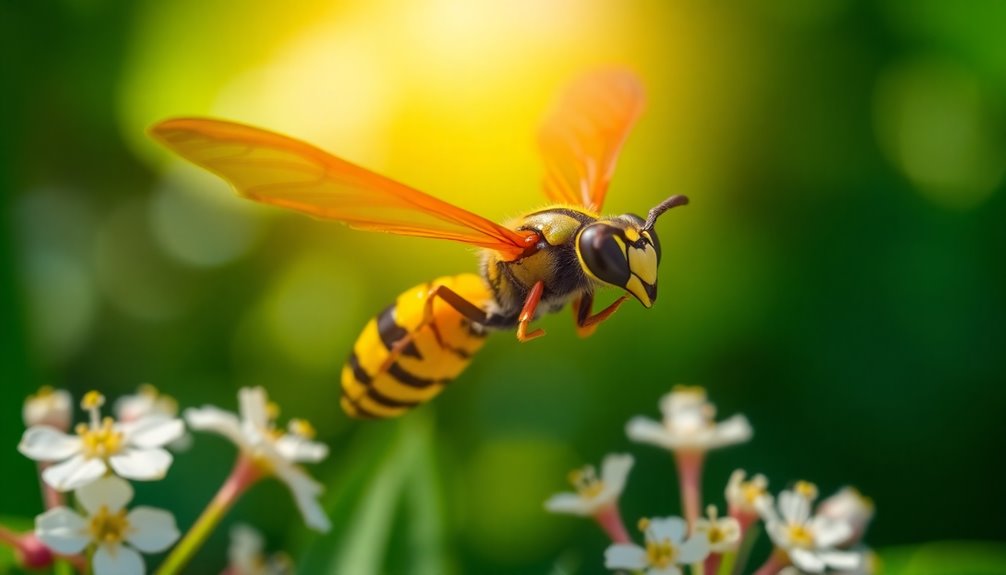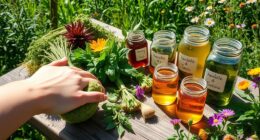Foraging season varies by region and climate, making it essential to know the best times for your area. Spring is great for delicious wild greens like dandelion and nettles from March to June. In summer, you'll find ripe berries from June to August and abundant mushrooms in humid woods. Fall brings a harvest of nuts and mushrooms, while winter offers hardy greens and winter chanterelles in milder climates. Always keep local availability in mind, and you'll improve your foraging success. There's much more to discover about seasonal varieties and techniques waiting for you!
Key Takeaways
- Spring (March to June) is ideal for harvesting wild greens like dandelion, nettles, and ramps, along with early berries like strawberries.
- Summer (June to August) focuses on berry foraging, with ripe blackberries and raspberries, along with abundant mushrooms and leafy greens.
- Fall (late September to early November) features mushrooms like chanterelles and porcini, plus ripening nuts like acorns and hickory nuts.
- Winter offers foraging opportunities for hardy greens like chickweed and miner's lettuce in milder climates, along with winter mushrooms.
- Foraging seasons vary based on regional climate, so understanding local patterns enhances successful harvesting.
Understanding Foraging Seasons
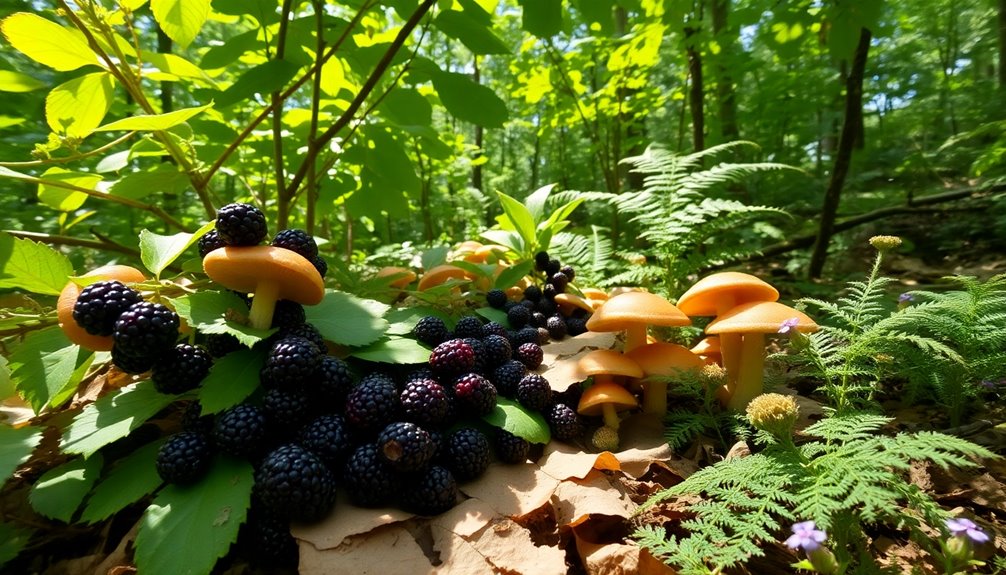
Understanding foraging seasons is essential for anyone looking to gather wild edibles effectively. The availability of these natural treasures varies considerably by regional climate and seasonal patterns.
In spring, you can expect to find tender greens like dandelion and nettles emerging as the snow melts and temperatures rise. This is the time to enjoy the fresh, vibrant flavors of spring greens.
As you shift into summer, the focus moves to berry foraging. Strawberries, blackberries, and blueberries typically reach their peak between June and August. Keeping an eye on local conditions is key, as timing can differ based on your area.
When fall arrives, the landscape transforms, bringing a bounty of mushrooms. Chanterelles and porcini often make their appearance from September to November, alongside ripe nuts like acorns and hickories.
Each of these wild edibles has specific growth cycles that align with the seasons, making it vital to be aware of what's available at any given time. By understanding these foraging seasons, you'll maximize your chances of discovering and enjoying the diverse offerings nature has to provide.
Spring Foraging Opportunities
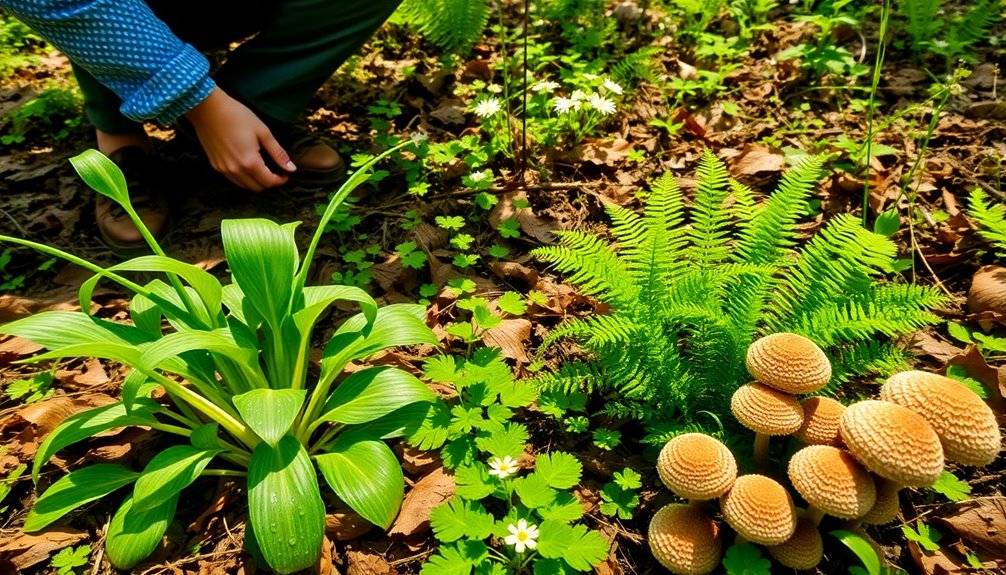
As spring rolls in, foraging opportunities burst forth, inviting you to explore the rich bounty of wild edibles. From March to June, this season is perfect for harvesting wild greens like dandelion, chickweed, and ramps, all of which are tender and flavorful.
You'll find that these greens not only enhance your meals but also provide essential nutrients.
Edible flowers such as violets and wild garlic emerge during this time, adding unique flavors to your culinary creations.
Late spring marks the beginning of berry season, with bushes laden with sweet blackberries and strawberries, offering delightful, nutrient-rich treats.
Don't overlook the mushrooms! Spring is prime time for foraging morels, which can be found from April to June and are highly sought after for their rich flavor.
As the weather warms, wild nuts like acorns and hazelnuts start maturing, presenting additional gathering opportunities toward the season's end.
Embrace the beauty of nature as you venture out to gather these spring treasures, enriching your meals and connecting you with the natural world around you.
Happy foraging!
Summer Harvesting Essentials

Summer's the perfect time to gather a variety of wild edibles, from sweet berries to nutritious greens and vibrant flowers. During this season, you can also discover basket weaving techniques that enhance your foraging experience by allowing you to carry more foraged goods comfortably. As you explore, it's essential to keep safety in mind and use effective gathering techniques to maximize your foraging experience. Additionally, consider incorporating non-perishable items into your foraging strategy to ensure you have a balanced food supply for emergencies. Remember, understanding seasonal growth patterns can significantly improve your foraging success. In regions like Wisconsin's wild bounty, you can find over 400 species of wild edibles available during summer months, with many of these species attracting a diverse range of pollinators. Let's look at the key summer edibles you can find and how to harvest them responsibly.
Key Summer Edibles
During the warm months, you'll find a bounty of wild edibles thriving in the great outdoors, perfect for foraging adventures.
Summer is an incredible time to explore and gather nutritious foods that nature offers. Here are some key summer edibles you should look out for:
- Berries: From June to August, ripe blackberries and raspberries provide a sweet and delicious treat.
- Leafy Greens: Lamb's quarters and purslane flourish during this season, offering tasty and nutritious additions to your meals.
- Mushrooms: Humid, wooded areas are home to chanterelles and morels, especially after rain, making summer prime time for mushroom foraging.
Additionally, keep an eye out for nuts like black walnuts, which start ripening in late summer, and wild herbs, such as mint and basil, which add flavor and nutrition to your dishes.
Foraging these summer edibles not only enriches your diet but also connects you with the natural world.
Foraging Safety Tips
Foraging for summer edibles can be an exciting way to connect with nature and enhance your diet, but it comes with responsibilities. First and foremost, you must accurately identify plants before consuming them. Many edible species have toxic look-alikes, so using field guides or foraging apps is vital for safety.
When you venture out in summer, steer clear of areas treated with chemicals, like roadside verges or industrial sites, to minimize exposure to harmful substances.
Dress appropriately; wearing long sleeves and pants will protect you from insect bites and scratches from thorny plants.
Don't forget to pack necessary tools, such as a knife for harvesting and multiple bags for organizing your finds. This preparation guarantees a safe and efficient foraging experience.
Lastly, always inform someone of your foraging location and expected return time, especially if you're foraging alone. This simple step boosts safety and preparedness in case of emergencies.
Seasonal Gathering Techniques
The thrill of harvesting seasonal edibles lies in the abundance of nature's offerings during summer. This season is perfect for foraging, providing a variety of nutritious options.
You'll want to keep an eye out for these summer treasures:
- Berries: Blackberries, raspberries, and blueberries ripen from late June through August, offering sweet snacks or additions to dishes.
- Wild Greens: Look for lamb's quarters, purslane, and dandelion greens, which are packed with vitamins and minerals when harvested in their prime. Engaging in foraging activities can also enhance cognitive skills as children learn about nature's bounty.
- Edible Flowers: Elderflower and chamomile bloom during summer and can enhance salads, teas, and syrups.
In addition to these, late summer is prime for gathering nuts like acorns and hazelnuts.
Another exciting aspect of summer foraging is mushrooms, with varieties like chanterelles and boletes emerging. However, always approach mushroom gathering with caution, as some edible varieties can have toxic look-alikes. It's also important to remember that certain herbs, such as cilantro's benefits, can be safely incorporated into your foraged meals, enhancing both flavor and nutrition.
Fall Foraging Highlights
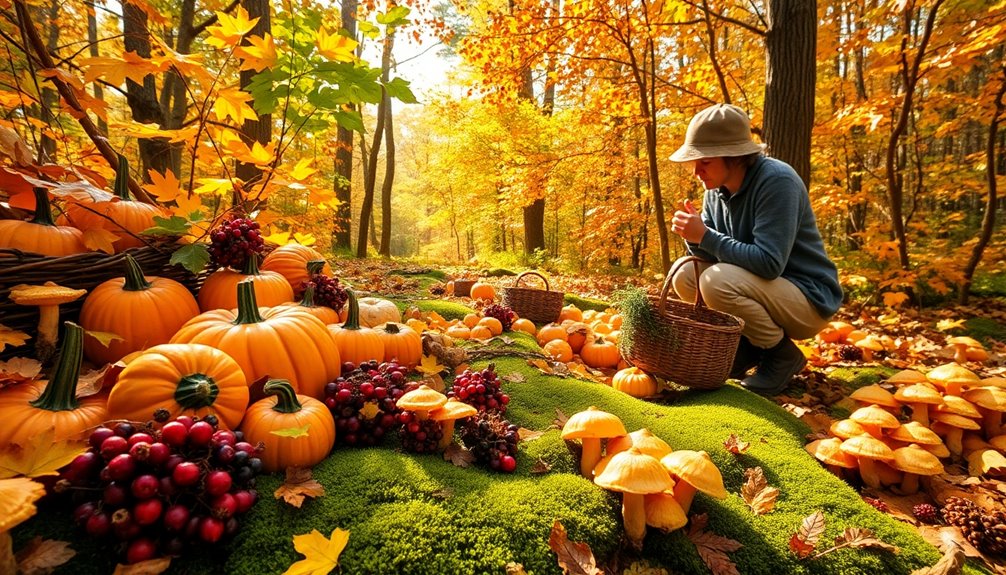
As fall sets in, you'll find a treasure trove of wild edibles ready for harvesting.
From nuts and mushrooms to wild fruits and greens, this season offers a rich variety of flavors waiting to be explored.
Get equipped with the right techniques and tips to make the most of your foraging adventures!
Seasonal Edibles Availability
Autumn brings a bounty of wild edibles just waiting to be discovered. This fall foraging season offers an array of delicious and nutritious options that you won't want to miss. As the temperatures dip, get ready to harvest:
- Mushrooms: Look for chanterelles, porcini, and morels from late September to early November.
- Berries: Blackberries and elderberries ripen in late summer to early fall, perfect for jams and desserts.
- Root Vegetables: Wild carrots and burdock become easier to dig up as the soil cools. Incorporating balanced nutrition into your meals can maximize the health benefits of foraged foods.
In addition to these, many wild greens like chickweed and dandelion thrive in the cooler weather, making them excellent additions to salads and cooked dishes. Remember to always be cautious and informed about potential side effects when foraging, as some wild edibles can be easily confused with toxic plants.
Foraging for these fall edibles isn't only rewarding but also a great way to connect with nature. Each item you gather contributes to a diverse and flavorful harvest that can enhance your meals.
Harvesting Techniques and Tips
When heading out for fall foraging, it's vital to equip yourself with the right tools and knowledge for a successful harvest. This season is perfect for gathering a variety of nuts, like acorns, hickory nuts, and walnuts, which ripen between late September and early November.
You'll also find abundant mushrooms, such as chanterelles and porcini, especially after the first rains from September to November.
To enhance your foraging experience, use a sturdy basket to collect nuts and wild fruits like persimmons and elderberries, which peak from late August to October.
A sharp foraging knife is essential for safely cutting mushrooms while minimizing damage to their mycelium. Additionally, understanding the seasonal shifts in local climate patterns can greatly improve your foraging success during this time.
Winter Foraging Insights
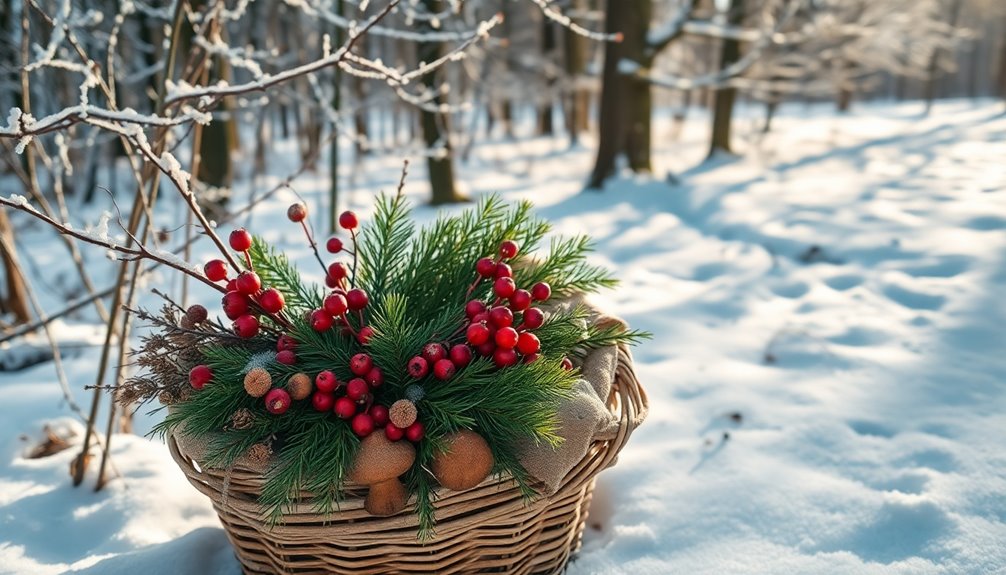
Winter foraging brings a unique opportunity to discover nature's hidden bounty, even amidst the cold. During this season, you can find various edible wild greens, like chickweed and miner's lettuce, which often thrive in milder climates.
If you know where to look, you'll be surprised by the food sources still available.
Consider these winter foraging treasures:
- Edible Wild Greens: Chickweed, miner's lettuce, and lamb's quarters can be harvested, especially in regions with less snow.
- Hardy Mushrooms: Look for winter chanterelles and other resilient varieties, particularly after warm spells or in sheltered areas.
- Nuts and Tree Bark: Acorns and hickory nuts are often stored and available. Plus, harvesting tree bark from birch can provide both food and medicinal properties.
Understanding local climate variations is key, as some areas may offer a more extended winter foraging season.
As you commence on your winter foraging journey, remember to respect the environment by harvesting sustainably and leaving enough for wildlife.
With a little effort, you can uncover a wealth of nutritious food sources right in your backyard.
Regional Variations in Foraging
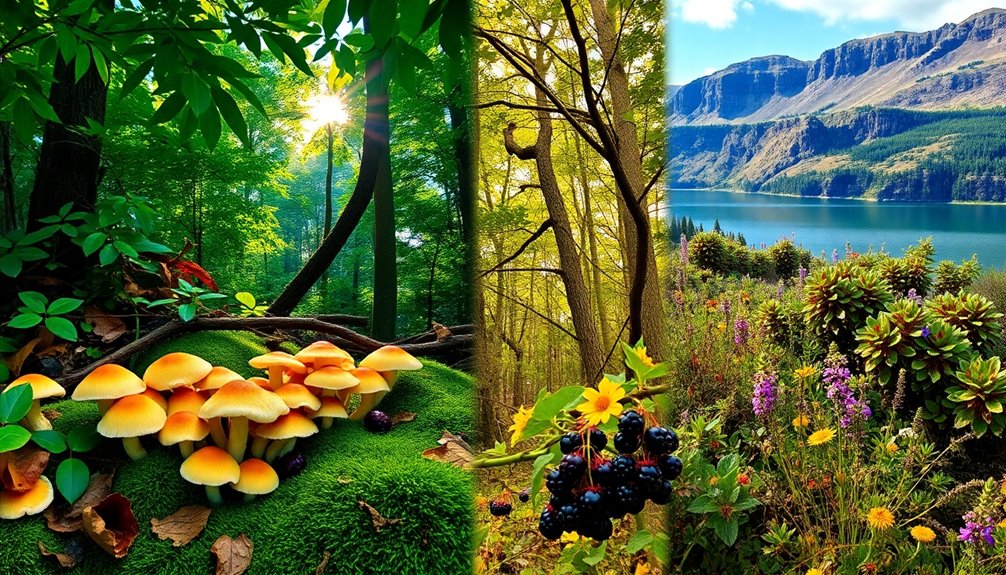
Foragers quickly realize that regional variations can dramatically affect what's available throughout the year. Understanding your local climate and seasonal changes is essential for identifying peak availability of wild edibles.
| Region | Best Times to Forage |
|---|---|
| Southeast United States | Late spring for dandelion greens and blackberries; late summer for mushrooms |
| Pacific Northwest | Spring for morels; summer for berries; autumn for various mushrooms |
| Northeast | Early spring for ramps and fiddleheads; late summer for berries and nuts |
In temperate zones, spring is often the prime time for wild greens, mushrooms, and early berries, while fall shines for nuts and late-season fruits. In the Southeast, you'll find an abundance of dandelion greens and blackberries peaking in late spring. The Pacific Northwest showcases an impressive variety, with morels appearing in spring and mushrooms peaking in autumn. For colder regions like the Northeast, early spring is best for ramps and fiddleheads, while late summer offers berries and nuts. Pay attention to local climate patterns to optimize your foraging adventures!
Tips for Successful Foraging
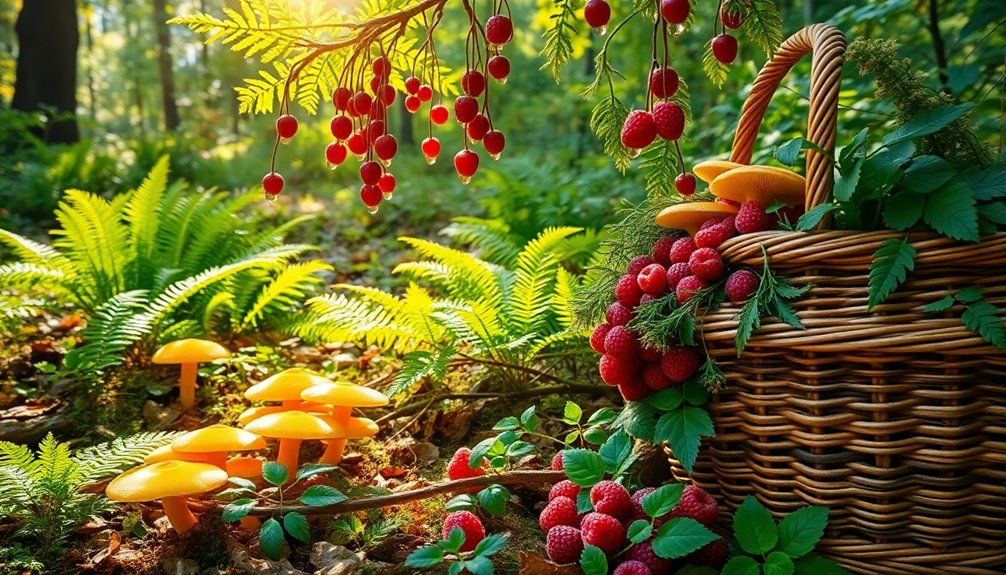
Mastering the art of foraging requires a keen awareness of your surroundings and the natural rhythms of local plant life. To increase your chances of a successful foraging season, consider these tips:
- Research seasonal availability: Understand when local edible plants like wild greens, berries, mushrooms, and nuts are at their peak.
- Join foraging groups: Connect with experienced foragers in your area. Their insights on timing and techniques can be invaluable.
- Keep a foraging journal: Document your findings along with seasonal changes. Tracking growth cycles will help refine your skills over time.
Familiarizing yourself with local edible plants not only enhances your foraging experience but also boosts your confidence in identifying what's safe to eat.
Remember that different regions have unique growth cycles, so stay informed about your local environment.
By actively engaging in the foraging community and keeping detailed notes, you'll become more adept at recognizing the best times to venture out for your favorite wild greens and other treasures.
Happy foraging!
Frequently Asked Questions
What Is the Golden Rule of Foraging?
The golden rule of foraging is simple: never take more than you need. This principle helps maintain the balance of nature, ensuring that ecosystems thrive for future generations.
When you're out foraging, consider using the Rule of Thirds: take one-third of what you find, leave one-third for others, and set aside one-third for future growth.
What Is the Best Season for Forage?
Spring's the ultimate treasure chest for foragers like you! It bursts with wild greens, herbs, and early flowers, making it the best season to plunge into nature's offerings.
As you explore, keep an eye out for ramps and dandelion greens.
Summer's your time for sweet berries, while fall showcases nuts and mushrooms.
Even winter has surprises, like hardy greens. Understanding your local patterns guarantees you won't miss out on all the deliciousness!
What Is the Forage Season?
The forage season varies by region and is influenced by local climate.
In spring, you'll find wild greens and mushrooms popping up, while summer brings a bounty of berries and nuts.
Autumn's perfect for fruits like apples and root vegetables.
Winter's options are limited, focusing on hardy roots and evergreen foliage.
What Time of the Year Is Best to Forage?
When it comes to foraging, timing is everything.
You'll find spring bursting with tender greens like dandelion and chickweed, while summer's ripe berries, such as blackberries and blueberries, beckon from June to August.
As fall rolls in, nuts and mushrooms take center stage.
Even in winter, you can uncover evergreen needles and certain roots.
Always remember, your local climate can change the game, so stay aware of what's available in your area.
Conclusion
So, as you venture into nature's grocery aisles, remember: you're not just collecting wild edibles; you're also playing a game of hide and seek with the seasons. Who knew finding your dinner could be so thrilling? Spring's fresh greens, summer's juicy fruits, fall's fungi, and winter's hidden treasures all wait for you. Just when you think you've mastered foraging, nature throws in a curveball. But hey, isn't that the fun of it? Happy hunting!


